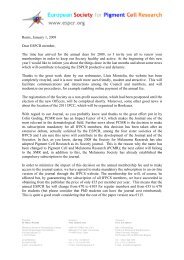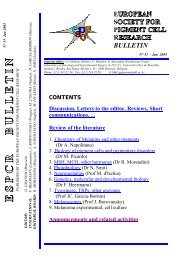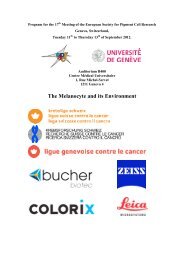espcrbulletin - European Society for Pigment Cell Research
espcrbulletin - European Society for Pigment Cell Research
espcrbulletin - European Society for Pigment Cell Research
You also want an ePaper? Increase the reach of your titles
YUMPU automatically turns print PDFs into web optimized ePapers that Google loves.
- Corry GN, Underhill DA.<br />
Pax3 target gene recognition occurs through distinct modes that are differentially affected by<br />
disease-associated mutations. <strong>Pigment</strong> <strong>Cell</strong> Res 18(6):427-438, 2005.<br />
- Forshew T, Khaliq S, Tee L, Smith U, Johnson CA, Mehdi SQ, Maher ER.<br />
Identification of novel TYR and TYRP1 mutations in oculocutaneous albinism. Clin Genet<br />
68(2):182-184, 2005.<br />
- Garcia-Borron JC, Sanchez-Laorden BL, Jimenez-Cervantes C.<br />
Melanocortin-1 receptor structure and functional regulation. <strong>Pigment</strong> <strong>Cell</strong> Res 18(6):393-410,<br />
2005.<br />
- Griffin AE, Cobb BR, Anderson PD, Claassen DA, Helip-Wooley A, Huizing M, Gahl WA.<br />
Detection of hemizygosity in Hermansky-Pudlak syndrome by quantitative real-time PCR. Clin<br />
Genet 68(1):23-30, 2005.<br />
- Gupta PB, Kuperwasser C, Brunet JP, Ramaswamy S, Kuo WL, Gray JW, Naber SP, Weinberg RA.<br />
The melanocyte differentiation program predisposes to metastasis after neoplastic<br />
trans<strong>for</strong>mation. Nat Genet 37(10):1047-1054, 2005.<br />
Abstract: The aggressive clinical behavior of melanoma suggests that the developmental origins of<br />
melanocytes in the neural crest might be relevant to their metastatic propensity. Here we show that<br />
primary human melanocytes, trans<strong>for</strong>med using a specific set of introduced genes, <strong>for</strong>m melanomas<br />
that frequently metastasize to multiple secondary sites, whereas human fibroblasts and epithelial<br />
cells trans<strong>for</strong>med using an identical set of genes generate primary tumors that rarely do so. Notably,<br />
these melanomas have a metastasis spectrum similar to that observed in humans with melanoma.<br />
These observations indicate that part of the metastatic proclivity of melanoma is attributable to<br />
lineage-specific factors expressed in melanocytes and not in other cell types analyzed. Analysis of<br />
microarray data from human nevi shows that the expression pattern of Slug, a master regulator of<br />
neural crest cell specification and migration, correlates with those of other genes that are important<br />
<strong>for</strong> neural crest cell migrations during development. Moreover, Slug is required <strong>for</strong> the metastasis of<br />
the trans<strong>for</strong>med melanoma cells. These findings indicate that melanocyte-specific factors present<br />
be<strong>for</strong>e neoplastic trans<strong>for</strong>mation can have a pivotal role in governing melanoma progression.<br />
- Helip-Wooley A, Westbroek W, Dorward H, Mommaas M, Boissy RE, Gahl WA, Huizing M.<br />
Association of the Hermansky-Pudlak syndrome type-3 protein with clathrin. BMC <strong>Cell</strong> Biol 6,<br />
33, 2005.<br />
- Ito S, Suzuki T, Inagaki K, Suzuki N, Takamori K, Yamada T, Nakazawa M, Hatano M, Takiwaki<br />
H, Kakuta Y, Spritz RA, Tomita Y.<br />
High frequency of Hermansky-Pudlak syndrome type 1 (HPS1) among Japanese albinism<br />
patients and functional analysis of HPS1 mutant protein. J Invest Dermatol 125(4):715-720,<br />
2005.<br />
- Iwakawa J, Matsuyama W, Watanabe M, Yamamoto M, Oonakahara K, Machida K, Higashimoto I,<br />
Niiyama T, Osame M, Arimura K.<br />
Hermansky-Pudlak syndrome with a novel mutation. Intern Med 44(7):733-738, 2005.<br />
- Jannot AS, Meziani R, Bertrand G, Gerard B, Descamps V, Archimbaud A, Picard C, Ollivaud L,<br />
Basset-Seguin N, Kerob D, Lanternier G, Lebbe C, Saiag P, Crickx B, Clerget-Darpoux F,<br />
Grandchamp B, Soufir N, Melan C.<br />
Allele variations in the OCA2 gene (pink-eyed-dilution locus) are associated with genetic<br />
susceptibility to melanoma. Eur J Hum Genet 13(8):913-920, 2005.<br />
1431







